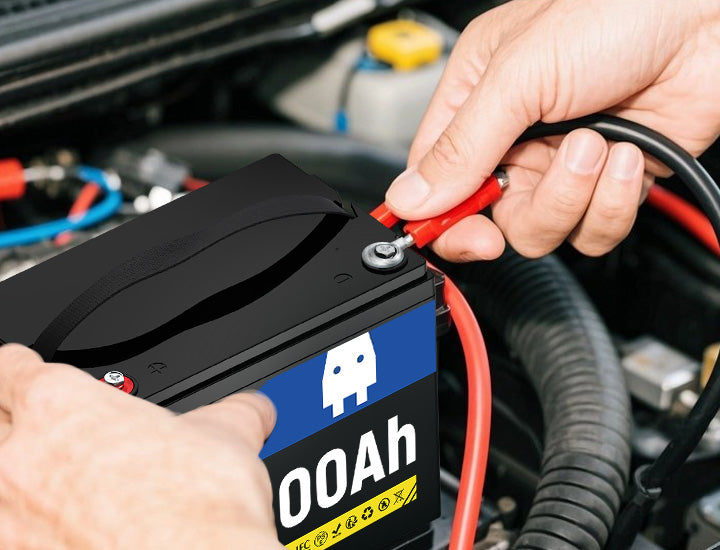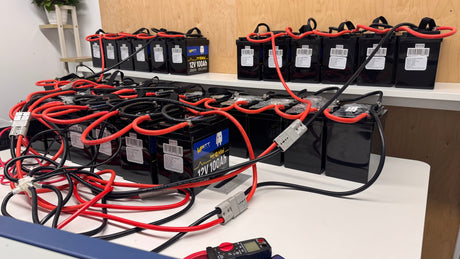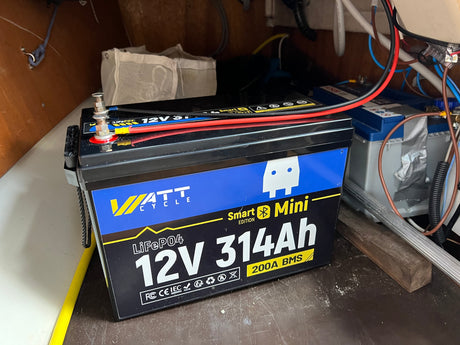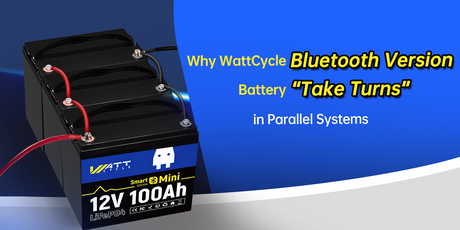A good charge is the heartbeat of any LiFePO4 lithium battery. Keeping your WattCycle deep cycle LiFePO4 battery topped up correctly ensures you get the full life cycle potential out of every cell, meaning more power for your RV adventures or off-grid projects. With consistent, balanced lithium battery charging, you’ll enjoy stable voltage, predictable run-times, and a smoother experience on every outing.
Both overcharging and undercharging sneakily sap your battery’s strength over time. Pushing voltage too high without the right cut-off can stress cells, leading to capacity fade or safety risks, even when your BMS over-current protect is in place. On the flip side, running your pack habitually low causes cell imbalance, voltage sag, and reduced usable capacity, so you might find yourself stranded just when you need power the most. Proper charging practices guard against these hidden performance drains and keep your system running reliably for years to come.
What Is Overcharging & Why Is It Harmful?
Overcharging happens when a lithium battery is pushed beyond its designed voltage cutoff during lithium battery charging. In a LiFePO4 battery pack, each cell should top out around 3.65V; forcing it higher stresses the electrodes and electrolyte, even if your BMS over-current protect kicks in to limit excessive current.
Common symptoms you’ll notice in your LiFePO4 battery:
- Inflated or swollen case: Excessive voltage causes gas generation between layers.
- Heat buildup during charge: A hot pack, even with cooling, signals cells are under duress.
- Charger never reaches “full” status: Constant trickle current indicates the BMS is cutting in.
- Rapid voltage drop under load: Cells lose balance and can’t hold voltage under draw.
Long-term effects on capacity, safety, and cycle life
Pushing a LiFePO4 lithium battery past its ceiling voltage gradually wears down the cathode structure, causing irreversible capacity loss. Over time, repeated overcharge cycles can weaken internal separators and lead to increased self-discharge rates, reducing usable run-time by 10–20 % or more. In worst-case scenarios, the risk of thermal runaway climbs, so sticking to proper charge parameters not only preserves your battery’s lifespan but also maintains the safety margin built into every WattCycle deep cycle pack.
What Happens When You Undercharge Your LiFePO4 Battery?
Explaining Undercharge and Its Typical Causes
Undercharging occurs when your lithium battery never reaches its full voltage during lithium battery charging, often stopping well below the ideal 3.30–3.35V per cell threshold. This can happen if you’re using a generic charger without a proper LiFePO4 profile, relying too much on solar panels in low sunlight conditions, or habitually “topping up” instead of running a full charge cycle. Even with BMS over-current protect guarding against high current faults, there’s no built-in cut-off to force a full charge, so your pack can languish at a partial SOC (state of charge).
How Partial or Shallow Charges Erode Usable Capacity
Skipping full charge cycles keeps cells out of balance. Over time, some cells stay perpetually undercharged compared to their neighbors, reducing the pack’s overall usable capacity by 5–15 %. Think of it like never fully filling a water jug—you’ll always run out sooner than expected. Regularly giving your LiFePO4 battery a floor-to-ceiling charge helps each cell catch up and share the load evenly.
From Voltage Sag to Reduced Run Time
When your pack sits in that “half-charged limbo,” you’ll notice voltage sag under load—lights dimming, inverters shutting off prematurely, or longer crank times on your engine. Run-time shrinks because you’re only accessing a fraction of the battery’s rated amp-hours. Ultimately, undercharging accelerates cycle-life loss just as surely as overcharging does, so it pays to use a smart charger or periodically force a full charge to keep your WattCycle LiFePO4 battery delivering peak performance.
Top Tips to Prevent Overcharging
1. Choose the Right Charger
Using a charger specifically designed for deep cycle LiFePO4 lithium battery charging means you get the correct charge profile every time. Generic or lead-acid chargers often push voltage too high or don’t step down properly, which can stress cells. Look for a unit labeled “LiFePO4” with multi-stage charging and automatic cut off to protect your pack.
2. Leverage Your BMS Over-Current Protect
Every WattCycle LiFePO4 battery comes equipped with BMS over-current protect, a built-in watchdog that cuts off excessive current the moment it detects a spike. That safeguard not only prevents overheating but also stops tiny overcharge events before they compound. Trust your BMS to do the heavy lifting—just make sure it’s properly calibrated and firmware is up to date.
3. Monitor Voltage & Temperature
Keep an eye on voltage in real time with smartphone apps or inline volt-meters that speak to your charger via Bluetooth. Temperature sensors give a second layer of defense; if your cells start to warm up past 45 °C, it’s time to pause that lithium battery charging session. Simple dashboards let you see both voltage and heat trends at a glance, helping you catch an overcharge before it becomes a problem.
4. Set Proper Charge Parameters
Aim for a maximum float voltage of about 3.40–3.45V per cell and never exceed 3.65 V, which is the safe cutoff for LiFePO4 batteries. Likewise, limit the charge current to around 0.2 C (for a 100 Ah pack, that’s 20 A) unless your BMS supports higher bursts. Sticking to these voltage and current guidelines keeps each cycle gentle on your cells, extending your battery’s usable life without cutting corners.
Top Tips to Prevent Undercharging
1. Use a Smart Charger with Multi-Stage Profiles
A charger with dedicated LiFePO4 profiles will automatically run through bulk, absorption, and float stages—so you don’t have to babysit your lithium battery charging. Bulk mode pushes current until you hit the target voltage, absorption holds that voltage to top off every cell, and float maintains a gentle trickle. This full-cycle approach ensures your WattCycle deep cycle battery reaches the proper 3.30–3.35V per cell before tapering off, keeping every cell balanced and healthy.
2. Avoid Frequent Partial Charges
It’s tempting to “tack on” a quick top off whenever you remember, but shallow or partial charges leave cells at uneven states of charge. Over weeks of irregular charging, some cells lag behind and drag down your pack’s overall capacity. Instead, aim for periodic full cycles—especially after heavy use—so your LiFePO4 battery resets its state of charge completely and stays in peak condition.
3. Schedule Regular Maintenance Charges
If your battery sits idle—during off-season storage or between weekend trips—it can slowly self-discharge. Plan a monthly maintenance charge: bring your pack back up to float voltage (around 3.45V per cell) and let your charger’s cut-off step in. This simple habit preserves usable capacity and avoids the deep-discharge zone that stresses cells and shortens cycle life.
By above these tips—using smart multi-stage charging, avoiding constant topping-up, and scheduling maintenance—you’ll keep undercharging at bay and get the most out of your WattCycle LiFePO4 lithium battery.
Best Practices for Long-Term LiFePO4 Health
Ideal Charging Environment
Keep your LiFePO4 battery in a spot that’s cool, dry, and well-ventilated—cells “breathe” better when heat can’t build up. Aim for ambient temperatures between 10 °C and 30 °C during lithium battery charging to avoid stressing the chemistry. Make sure all cable connections are clean and tight; a loose terminal is like a weak handshake, and it can introduce resistance that turns into unwanted heat.
Storage Guidelines: Float-Charging vs. Long-Term Cut Off
If you’re parking your deep cycle battery for a month or two, float-charging at about 3.45V per cell keeps things happily topped up without overdoing it. For true long-term storage (over three months), let the pack rest at around 50 % state of charge—roughly 3.30V per cell—and disconnect or switch off your charger to prevent tiny self-discharge drips from creeping into undercharge territory. Learn more about the storage and maintenance of lithium batteries.
Firmware Updates and Charger Calibration
Treat your BMS over-current protect and smart charger like software-driven guardians: regular firmware updates patch any quirks and improve how they manage current flows. Likewise, calibrate your charger every six months—many units drift slightly over time, which can tip the balance toward mild overcharge or undercharge. A well-tuned charger and up-to-date BMS ensure your LiFePO4 lithium battery ages gracefully, cycle after cycle.









